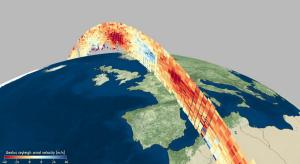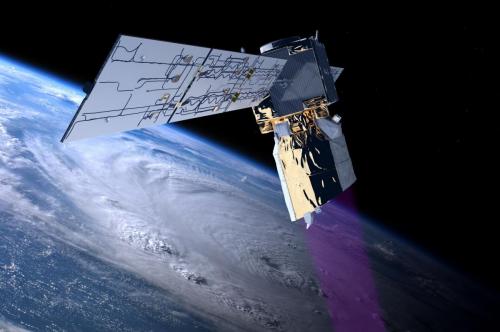Aeolus goes public
Delivering new information about Earth’s winds, ESA’s Aeolus mission has already been hailed a success. Today, this remarkable satellite mission has yet again achieved new heights: its data are now being distributed publicly to forecasting services and scientific users in less than three hours of measurements being made from space.
Aeolus is one of ESA’s Earth Explorer missions, which all set out to demonstrate how new ways of observing Earth can advance our understanding of how the planet works as a system.

Wind profile from Aeolus 6 May 2020
Carrying one of the most sophisticated instruments ever to be put into orbit, Aeolus is the first satellite mission to directly profile Earth’s winds from space.

Understanding Earth’s winds
It works by emitting short, powerful pulses of ultraviolet light from a laser and measures the Doppler shift from the very small amount of light that is scattered back to the instrument from molecules and particles to deliver vertical profiles that show the horizontal speed of the world’s winds in the lowermost 26 km of the atmosphere.

New Antarctic ground station for Aeolus increases data flow
ESA’s Director of Earth Observation Programmes, Josef Aschbacher, said, “Aeolus was never going to be an easy satellite mission to develop, and, indeed, it took some years to get it right before it could be launched. The wait was certainly worth it though, and in the 20 months that it has been in orbit, it has gone from strength to strength that will lead to benefits for science and society alike.
“And, thanks to all the teams involved and in agreement with EUMETSAT, we are very proud to announce that as of today, Aeolus’ data are being distributed in near-real time for numerical weather prediction beyond the Aeolus core user community.”
ESA’s Peggy Fischer said, “A huge amount of work has gone into perfecting Aeolus’ data before today’s public release. This satellite technology is completely new so we have had to understand and correct certain biases in the data that were not known before launch.
“To do this, key Aeolus experts from different organisations worked together in the Data Innovation and Science Cluster team – the Aeolus DISC, to validate and optimise the data processing and bias correction methods.”
ESA’s Jonas von Bismarck, added “As the last and particularly tricky bit of the puzzle, a bias related to temperature variations across the instrument’s telescope was corrected, making the data ready to be used in numerical weather prediction without the forecast centres having to carry out further complex corrections.”
The European Centre for Medium-Range Weather Forecasts (ECMWF) in the UK has already been including Aeolus data in their forecasts since January, relying on their own bias correction scheme.
Source: European Space Agency
- 249 reads
Human Rights
Ringing FOWPAL’s Peace Bell for the World:Nobel Peace Prize Laureates’ Visions and Actions

Protecting the World’s Cultural Diversity for a Sustainable Future

Global Celebration of International Day of Conscience: Dr. Hong, Tao-Tze Unites Participants from 63 Nations

The Peace Bell Resonates at the 27th Eurasian Economic Summit

Declaration of World Day of the Power of Hope Endorsed by People in 158 Nations

Post-authoritarian Bureaucracy Violence :Unveiling Ceremony at the Injustice Site of the 1219 Incident

Puppet Show I International Friendship Day 2020